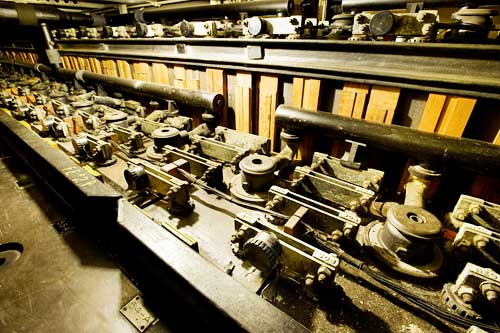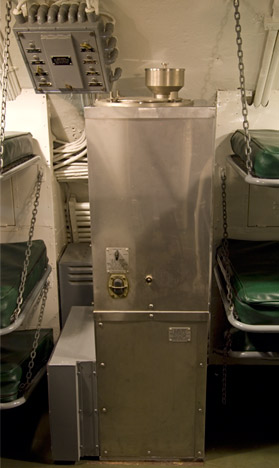|
The upper level of this compartment holds 36 bunks and was the main
enlisted berthing area on Pampanito. On some patrols there were more
men than bunks, which meant that some members of the crew had to "hot bunk"
or share available bunks. One man would use the bunk while another was
on duty. The normal procedure was for 3 men to use 2 bunks, so each crew member
would have a chance to get closer to a full watch period of sleep all at one time.
Imagine too what this compartment must have been like on Pampanito's third war patrol. During this patrol she rescued 73 British and Australian former prisoners of Imperial Japan after their ship had been sunk and they spent four days in the water. There were 162 men aboard at that point, 67 men were in the after torpedo room, the 6 most seriously ill were kept here in after battery, and the rest wherever they could fit. It took 5 days to get to safety. (See the Historic Photographs
and Rescue 16 mm Film)
In the
after section of this compartment is the crew's head with 2 toilets,
the washroom, 2 showers and a washing machine. About 70 men shared these facilities. (See the Crew's Washroom, and Crew's Head.) Below the showers and heads is Sanitary Tank #2

Photo of batteries aboard USS Ling
This compartment is called the after battery because under the deck were 126 lead acid battery cells, each weighing over
a ton. These cells comprised one of the vessel's two main storage batteries
and, incidentally, they looked just like the batteries of your automobile
but much, much bigger. The cells were stacked in six rows of twenty-one
cells each with hard rubber panels placed on top to serve as a working
deck. Each cell produced two volts of DC power and all the cells were wired
to each other in series to produce the 250 volts DC power used by most
of the equipment aboard. Located above the hatch to the battery well is
a "soft patch," so called because the patch could be unbolted and removed
to allow the replacement of the batteries.
At the forward bulkhead on the port side is the medical locker. Pampanito
did not have a doctor aboard. A well trained Pharmacists Mate, qualified
for independent duty, tended to the health of the crew. Aboard two WW II submarines emergency appendectomies were performed
on the wardroom tables by the Pharmacists Mates.
The air in this compartment was usually a little better than in other
places: the smell of diesel oil was masked a bit by the aroma of steaming
coffee, freshly baked bread and pastries, or perhaps roast beef from the
galley.

The large stainless steel structure on the port side is an ice cream freezer. It was extraordinary that such a small ship made room for the freezer. This may be the only luxury on the whole boat, but the Navy made every effort to provide the submariners the best food possible. More on this in the next compartment.
|